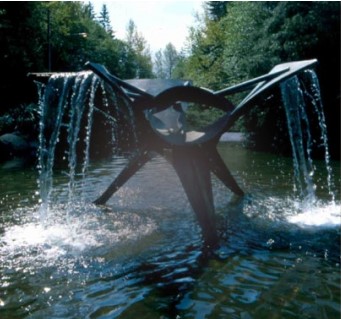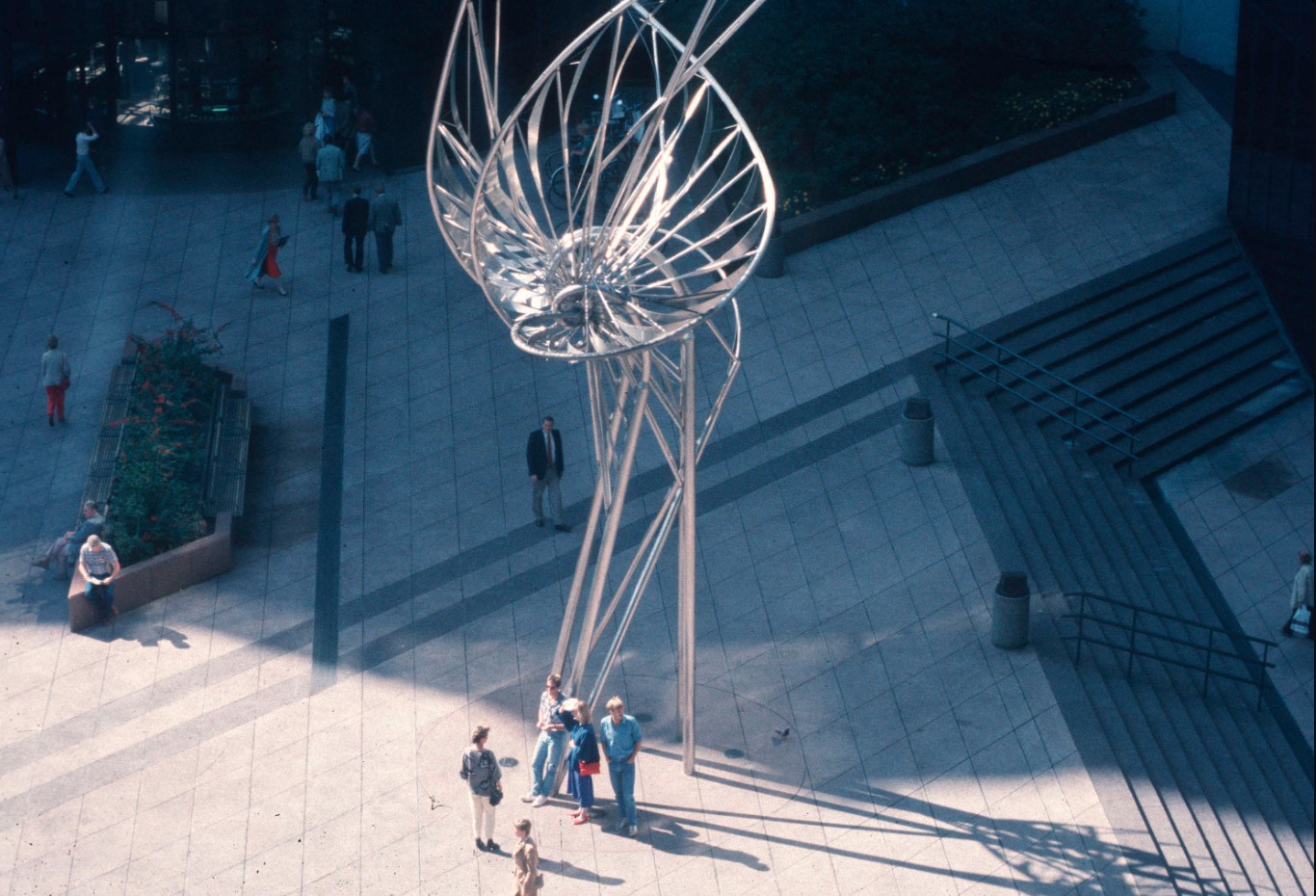George Norris was born in Victoria in 1928. He studied at the Vancouver School of Art. His sculptures are spread around Vancouver, Victoria and Calgary, but his most famous is probably The Crab (1967) that sits outside the Museum of Vancouver.
Last week I had the pleasure of writing about Svend-Erik Eriksen and showcasing some of his fabulous photos of early Vancouver. I’ve been running a different photo on my Facebook page each day this week, and this one of the people lined up to catch a bus outside Eatons at Granville and Georgia really caught my eye.

There’s so much going on from the clothes of those waiting for the Brill trolley bus to the Clark Kent-style telephone booth. But I was curious about the sculpture shown right of frame.
It was created by George Norris, and if you haven’t heard of him, I’m sure you know his work.
The Crab (1967)
His famous crab sculpture sits outside the Museum of Vancouver and if you spend any time on the North Shore, you’ll recognize his 1971 fountain sculpture at the corner of Capilano Road and Ridgewood Drive.

He created the concrete frieze outside Postal Station D on Pine Street (1967), Mother and Child at UBC’s East Mall (1955) and a terracotta and brick sculpture outside UBC’s Metallurgy building (1968).
Pacific Centre:
In 1973, he was commissioned to design a sculpture for the newly created plaza outside the TD Bank building at Granville and Georgia.
The polished steel sculpture took him a year to create and was 13.5 metres high–roughly the height of a four-storey building. “It’s an abstract piece and I’ve attempted to give a sense of release to the space that is free and open. I wanted people to see it their own way, so it has no name,” he said at the time.

At the time of its conception, Norris had fought for a plaza that also included trees and shrubs. “But they weren’t interested because they wanted to get everybody down into the underground mall like moles,” he told a Sun reporter in 1987.
Scrapped:
George was understandably upset because Pacific Centre had decided his work was “no longer appropriate” for a planned redesign of the plaza. And, the piece which cost more than $30,000 and by then valued at $50,000, was shipped off to Surrey.
Surrey couldn’t figure out what to do with it, so the city took it apart and put it into storage. A few years later, a worker came across it and thinking it was scrap metal sent it off for recycling. When city manager Doug Lychak was called out on it, he told a reporter: “It was an honest mistake.” Or in other words, shit happens.
“The sculpture to me was like a silent song,” said Norris who died in 2013.
For more on George Norris’s work see:
- Murray Maisey’s Vancouver as it Was blog
- Public Art in Vancouver
© All rights reserved. Unless otherwise indicated, all blog content copyright Eve Lazarus.



10 comments on “The Art of George Norris”
Do you mean Ridgewood not Ridgeway?
Great article on familiar public art. Nice to have a name to go with the pieces!
Yes I did! Thanks for the catch Jan and glad you liked the story.
The Svend-Erik photo shows a 1949 Brill T-48 model in B.C. Hydro colours. Those phone booths were futuristic, but the pay phones inside were still vintage “drop coin” versions. The Granville Mall original post-top street lights were closely spaced and incandescent. They had a cluster of small tube type bulbs as used in display cases. The light output was low level and free from glare, and complemented the street at night. Later they were replaced with intense high-pressure orange sodium vapour bulbs in the same fixture. The night time ambience was never the same again. You can see the top of the Marine Building from this vantage point.
Angus, thanks so much for adding all this information. Your memory for detail is truly amazing!
Commissioned by who ? If Vancouver then its city property and never should have been taken there. Who ordered it given away for nothing?
The “ city” I have very sadly has discovered is not council but union do nothings with seemingly no guidance. The condition of the streets, trees, garbage receptacles, sidewalks is not “ worldclass” by any measure. The last civic election the voters wanted change but nothing has and its worse than ever.
I was an art school student in the 70’s, and a major in sculpture. I have always bee a huge fan of George Norris’ work, and when I noticed the unnamed sculpture at Pacific Center, was gone, I was appalled. I believe there was an “anti modern” movement that purposefully removed and often destroyed public works. Does anyone remember the fuss about the monumental yellow Robert Murray piece , “Cumbria” at the entrance to the airport. It was relocated to the Belkin gallery at UBC. What do people want, dead guys on horses?
I always liked that sculpture. What a pathetic end for it. A cursed intersection with the loss of Birks as well.
hi ya.. i too was a great admirer of ole birk’s building an the clock or thee clock that was used to let holiday makers from outisde the city me there an decide what to do, first where to go for lunch.. yess, as a youngster i have still memories of those days in t
he 40’s an early 50’s.. cheers for our annoyance of it: loss of birk’s building .. i too was, almost too sad to read it twice .. lol helena
That was such an iconic sculpture in downtown Vancouver for awhile. I have photos of it I took in the early 70s. Sorry to hear of its ultimate fate.
[…] the Scotia Tower and the squat little building that currently houses London Drugs. Across the road, George Norris’s four-storey-high steel sculpture appears, and quickly disappears, after a city worker mistook it […]